Six years ago Jacqueline and I undertook a four day walk through Wester Ross, from Dundonell on the shores of Little Loch Broom to Kinlochewe at the head of Loch Maree. This vast tract of land is known as Fisherfield Forest, not a forest of trees but a ‘deer forest’, an area of land reserved to manage a population of red deer. This is, for Scotland at least, a wild and remote place, and for us it had a feeling of wildness and remoteness, of being on our own, of relying on ourselves and of exploring an area which relatively few people visit, and no-one inhabits.
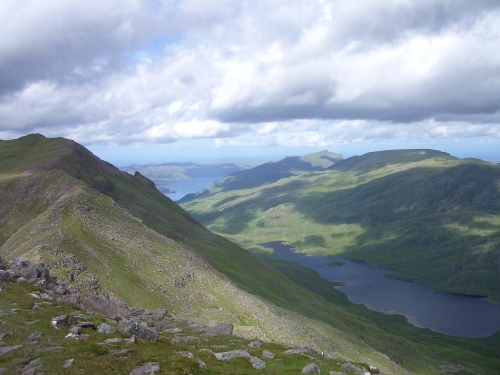
Loch Maree and Lochan Fada from Slioch
It was a time when we were getting to know one another and getting to know our own country too. Neither of us had ever undertaken such a long hike through and over the mountains, and we were excited about it. This was a new place for us and we were enthused about exploring this part of the country and spending time together.
We planned our trip to coincide with the John Muir Trust‘s ‘Journey for the Wild’, a 2500 mile journey throughout the UK, sections of which were undertaken by thousands of people to celebrate and promote the value of wild places. Our wild place was Fisherfield, and during our planning we decided to record the wildlife we saw along the way. It was our intention to write about the journey immediately when we returned home, but day-to-day life quickly took over and time disappeared; the moment quickly passed. All our great intentions evaporated and we never did write about it. Now, looking back at the photographs of that journey vividly brings back the joy we had. I can see it in our faces. So, six years down the line, I think it’s about time I put my thoughts about the trip down on paper.
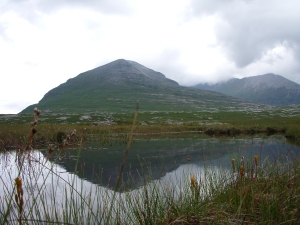
An Teallach from Gleann Chaorachain
We set out in the heat, first along the road from Dundonnell to Corrie Hallie and then following the track through Gleann Chaorachainn, with views of An Teallach as we come out of the woods. From a hillock close to Loch na Bràthan, we stop for a rest. The landscape unfolds; to the east, clouds skim over the Fannaichs, to the south, the hills beyond the Abhainn Strath na Sealga open out, the long ridge that starts with Beinn na Chlaidheimh and which is the way we will be going. Descending towards the river, the Shenevall bothy pokes into view. Tired after a hot day, we find a spot to camp at the foot of Beinn na Chlaidheimh, near the Abhainn Loch an Nid, the river fed from Loch an Nid that nestles beneath the steep crags of Craig Rainich. It’s boggy by the river. We look and find many bog-loving plants; the yellow-spiked bog asphodel, fragrant bog myrtle, the white fluffy heads of cotton grass, and the insectivorous common butterwort (see picture).
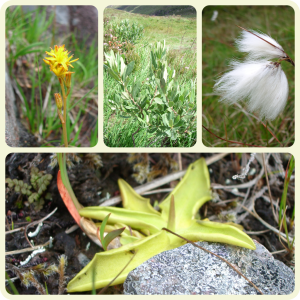
Bog-loving plants
The next morning we wake, refreshed (well, as refreshed as it’s possible to get when sleeping in a tent). We gain height quickly, climbing the rocky slopes of Beinn na Chlaidheimh. We hardly feel the rucksacks on our backs, but when we reach the bealach just south of the summit, decide to leave them anyway and walk the last five hundred metres to our first summit of the trip, our backs and shoulders feeling light and floaty.
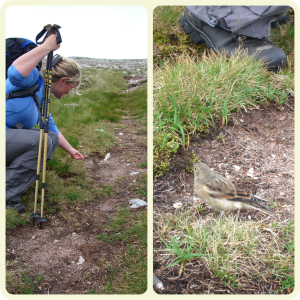
Jacqueline and the meadow pipit
As we head south along the broad ridge a little meadow pipit flits around us, occasionally stopping on a rock in front and seeming to watch us. We walk on and he follows us. Jacqueline turns quietly and tries to coax him to come over, which to our surprise, he does. Despite the weight of our rucksacks, the experience lifts us and the next few hours seem easy. We bounce along with a spring in our steps. How can so something so simple lift your heart?
We ascend Sgùrr Bàn, all sharp white rock, and Mullach Choire Mhic Fhearchair, scree and powdery white dust that slides away under your feet. Once we’re at the top, we feel we’re into our stride now, feeling good. We spot some wild mountain goats, completely disinterested in our presence. They look up for a few seconds and then go back to grazing – what meagre eating there must be here on these rocky slopes. In the bealach between Mullach Choire Mhic Fhearchair and Meall Garbh we find a spot that we think will make a grand camp. We’re at 800 metres now and don’t want to drop lower as it’ll only mean a further climb the next morning. I go off in search of water while Jacqueline sets up the camp. I come back to find the tent up and gear organised; Jacqueline’s picked what I think is a great wee spot with wonderful open views and a bit of shelter beside a little rocky outcrop.
We have a torrid time that night. Shortly before bed-time, the wind gets up and we realise, too late, that we’re sitting in a wind tunnel. The tent starts to flap and I start to wonder whether Jacqueline (being fairly new to putting up tents) has done it properly. I start to wonder what will happen if the tents blows away (either with us inside it, or with us left behind sitting on the ground). To top it off, the rain starts. We tell each other we need to get to sleep; tomorrow’s going to be the longest day of the expedition so far. Unsurprisingly, despite being tired, we sleep fitfully after lying in the dark for what seems like forever. I wake up at one point feeling as though I’m at sea and realise to my horror that water is gushing under the groundsheet of the tent; it feels like I’m floating on a water-bed. Grabbing a torch, I search for leaks. No leaks, but I can clearly see a river rippling and oozing beneath us. I try to get back to sleep, not even slightly hopeful that we’re going to wake up dry.
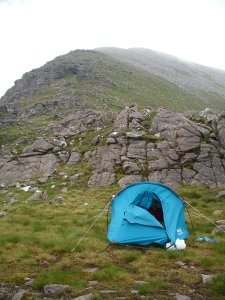
A good place to camp?
Later, Jacqueline wakes me with a start. Someone’s trying to get in to the tent, she says. I’m tired. I think she’s telling me what she’s being dreaming, but no, she’s actually whispering to me that there’s someone outside the tent who wants to get inside the tent. She could hear them speaking, she says. They tried to kick her head she says. I listen, intently. I can’t hear anyone. I listen some more. Still nothing, apart from the wind and the rain and the tent billowing around us. It’s then that I remember that we’re 800 metres up a mountain, that we’re at least fifteen miles from the nearest road and that it’s blowing an absolute hoolie out there. Not even the most dedicated pyschopath would travel out here on a night like this to murder us. I gently try to convince Jacqueline that no-one is there, but the darkness, tiredness and the strange sounds made when wind and rain whoosh through a wind tunnel have conspired to persuade her that we’re not going to make it through the night. It takes some time for my reassurances to take any effect.
We wake in the morning, exhausted. It’s day three. I crawl out of my sleeping bag, go outside and stretch. Thankfully, the rain has gone and the sun has reappeared. I look at our little tent and smile, impressed that it’s stayed up during the night and has remained water-tight. I’m impressed that Jacqueline has pitched it so well, too. How could I have doubted her?!
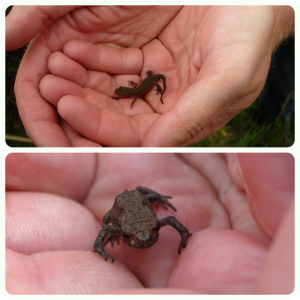
Palmate newt and toad
After breakfast, we have an easy walk over to Beinn Tarsuinn, our fourth munro of the trip. We continue looking for new and interesting plants and creatures and find some tiny toads, hiding in long grass, and down by a burn a palmate newt.
These few days will stay with me. I loved them, and loved spending this time with Jacqueline. It’s remarkable how well you get to know someone when you spend twenty fours a day with them and there’s no-one else around and no other distractions.
To find out what happened on day four, read Midges, Sweat and Tears on Slioch.

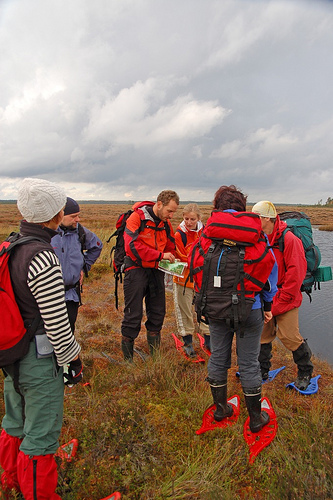







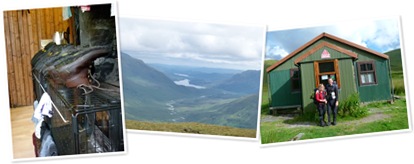








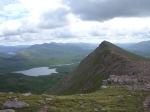


 Let’s take a minute and look at the context of this decision. The
Let’s take a minute and look at the context of this decision. The 


